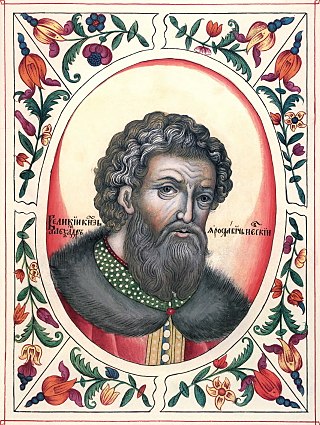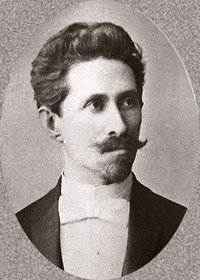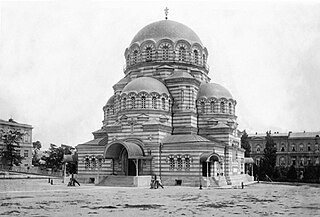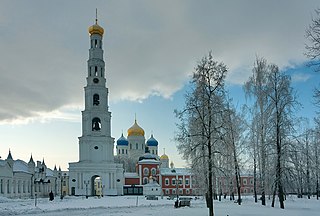
The Neva is a river in northwestern Russia flowing from Lake Ladoga through the western part of Leningrad Oblast to the Neva Bay of the Gulf of Finland. Despite its modest length of 74 kilometres (46 mi), it is the fourth-largest river in Europe in terms of average discharge.

Alexander Yaroslavich Nevsky was Prince of Novgorod, Grand Prince of Kiev (1246–1263) and Grand Prince of Vladimir (1252–1263).

Khamovniki District is a district of Central Administrative Okrug of the federal city of Moscow, Russia. Population: 102,730 (2010 Census); 97,110 (2002 Census).

The Alexander Nevsky Cathedral of Tallinn is an Eastern Orthodox cathedral in central Tallinn, Estonia. It was built in 1894–1900, when the country was part of the former Russian Empire. The cathedral is the city's largest cupola church. The late Patriarch Alexy II of Moscow (1929–2008) started his priestly ministry in the cathedral. It is the primary cathedral of the semi-autonomous Estonian Orthodox Church of the Moscow Patriarchate.

Cathedral Square or Sobornaya Square is the central square of the Moscow Kremlin where all of its streets used to converge in the 15th century.

The St. Alexander Nevsky Cathedral was a Russian Orthodox Cathedral in Saxon Square built in Warsaw, Congress Poland, then a part of the Russian Empire. The cathedral was designed by the distinguished Russian architect Leon Benois, and was built between 1894 and 1912. When it was finally completed, it was 70 metres in height, at that time, the tallest building in Warsaw.

Vosstaniya Square, before 1918 Znamenskaya Square, is a major square in the Central Business District of Saint Petersburg, Russia. The square lies at the crossing of Nevsky Prospekt, Ligovsky Prospekt, Vosstaniya Street and Goncharnaya Street, in front of the Moskovsky Rail Terminal, which is the northern terminus of the line connecting the city with Moscow. Administratively, the Vosstaniya Square falls under the authority of the Tsentralny District.

Alexander Nikanorovich Pomerantsev was a Russian architect and educator responsible for some of the most ambitious architectural projects realized in Imperial Russia and Bulgaria at the turn of the 20th century. An accomplished eclecticist, Pomerantsev practiced Art Nouveau, Byzantine, Russian Revival styles and collaborated with leading structural engineers of his period in creating new types of commercial buildings.

Holy Myrrhbearers Cathedral a local historical monument and church, built in 1909 in Baku, serves as the center of the Baku diocese.

The Russian Revival style comprises a number of different movements within Russian architecture that arose in the second quarter of the 19th century and was an eclectic melding of Byzantine elements and pre-Petrine architecture.

Basmanny District is a district of Central Administrative Okrug of the federal city of Moscow, Russia. Population: 108,204 (2010 Census); 100,899 (2002 Census).

The St. Alexander Nevsky Military Cathedral of Tiflis was an Orthodox Christian cathedral in downtown Tiflis, Georgia, constructed during the Imperial Russian rule in 1871-1872 and 1889–1897 and demolished by the Soviet authorities in 1930. The novel design of the cathedral became a standard for the emerging Neo-Byzantine style well before the cathedral was completed.

Nikolo-Ugreshsky Monastery is a walled stauropegic Russian Orthodox monastery of St. Nicholas the Miracle-Worker located in a suburb of Moscow, Dzerzhinsky. It is the town's main landmark and is featured on the city emblem.

Russian-Byzantine architecture is a revivalist direction in Russian architecture and decorative and applied arts, based on the interpretation of the forms of Byzantine and Kievan Rus' architecture. As part of eclecticism could be combined with other styles.

The Moskva Pool was, for a time, the world's largest open air swimming pool.

The Alexander Nevsky Cathedral is a Russian Orthodox cathedral church located at 12 Rue Daru in the 8th arrondissement of Paris. The closest métro station is Courcelles .

The Monument to Leo Tolstoy on Prechistenka was installed in Moscow in the courtyard of the State Museum of Leo Tolstoy. The granite sculpture was made in 1913 by sculptor Sergey Merkurov, and has been in its current location since 1972.

The Holy Trinity Cathedral of the Alexander Nevsky Lavra is a Russian Orthodox cathedral in Saint Petersburg. It is in the Diocese of Saint Petersburg and part of the Alexander Nevsky Lavra, where it is the cathedral church of the monastery complex.

Alexander Nevsky Square, formerly called Red Square, is a city square in Tsentralny District, Saint Petersburg. At the east end of Nevsky Prospekt, linking the street with the Alexander Nevsky Lavra, it is named after medieval Russian Prince Alexander Nevsky.



















